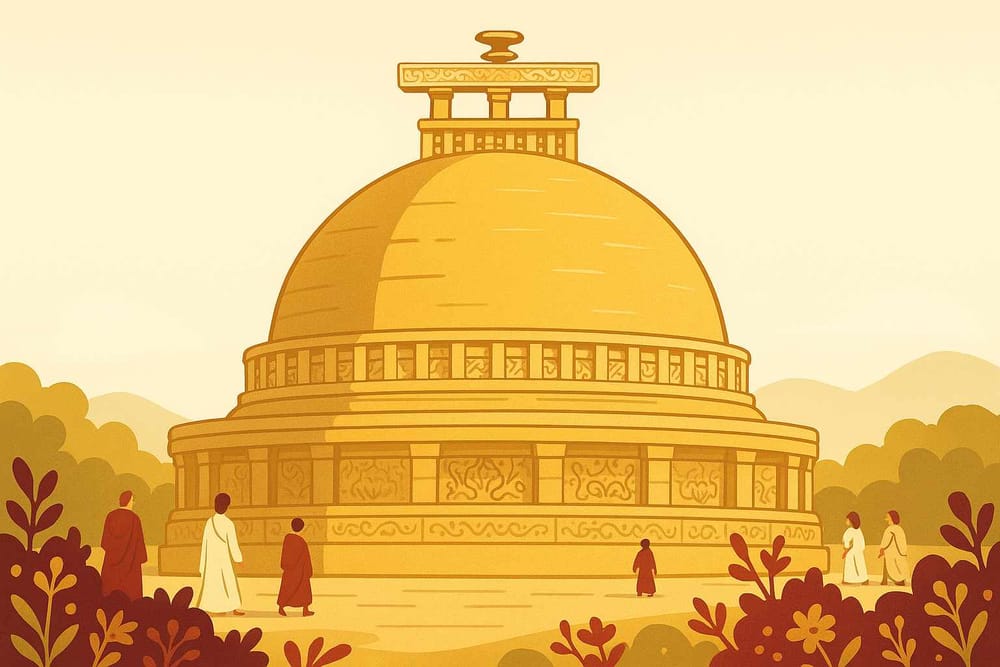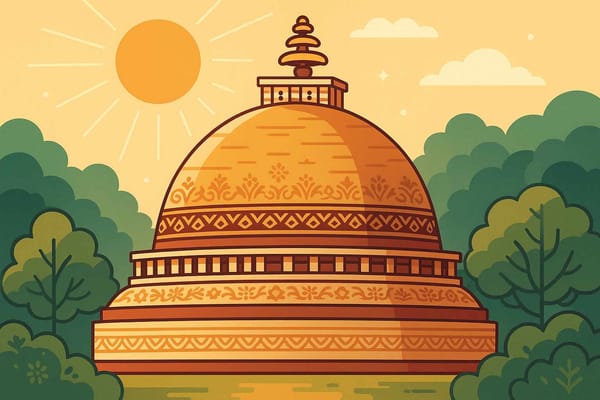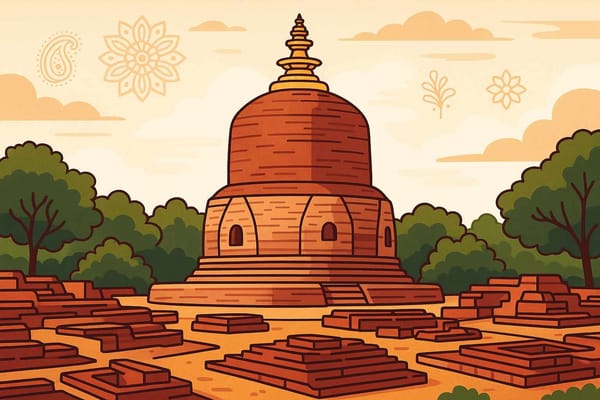
Dharmarajika Stupa-Time Travel Through Ancient History
Have you ever stood in a place so old that the very air seems to hum with stories? A place where every stone holds a memory, and the silence is filled with echoes of devotion from centuries past. That’s the feeling that washes over you when you learn about the Dharmarajika Stupa. It’s more than just a ruin; it’s a timeless connection to an era when faith reshaped empires, and a great king, Ashoka, walked the path of peace.
Nestled in the ancient city of Taxila, now in Pakistan, this stupa isn't just an architectural marvel. It is a powerful symbol of India's shared spiritual heritage, a testament to a time when the teachings of Lord Buddha travelled across lands, carried by the winds of change. Let's take a journey back in time, to understand the heart and soul of this sacred monument.
The Story Behind the Stupa: A King's Promise in Stone
The story of the Dharmarajika Stupa begins with Emperor Ashoka in the 3rd century BCE. After the brutal Kalinga war, a transformed Ashoka embraced Buddhism and earned the name 'Dharma Raja'—the Righteous King. He made it his life's mission to spread the message of Dhamma (righteousness, compassion, and non-violence). It is said he built 84,000 stupas across his vast empire, and the Dharmarajika was one of the grandest. Its very purpose was sacred: to enshrine the holy relics of the Buddha himself, turning Taxila into a spiritual beacon for devotees.
But why Taxila? In those days, Taxila wasn't just a city; it was a vibrant crossroads of knowledge, culture, and trade. It was a melting pot where ideas from Greece, Persia, and India mingled freely. By placing such a significant monument here, Ashoka ensured that the Buddha's teachings would resonate far and wide, touching the hearts of travellers, scholars, and seekers from across the known world.
An Architectural Marvel Born from Faith
Imagine the stupa in its full glory. It wasn't just a building; it was a cosmic diagram in brick and stone. Its design is deeply symbolic and speaks a language of its own.
- The Grand Structure: The main stupa has a massive circular base with a raised terrace, leading up to a dome that stood tall against the sky. A wide, paved path encircles it, designed for pradakshina—the meditative act of walking clockwise around a sacred object. It was a walking meditation, a way for devotees to physically and spiritually align themselves with the monument's energy.
- Stories in Stone: The stupa was part of a larger monastic complex. The entire area was adorned with intricate carvings and sculptures created in the unique Gandhara style, which beautifully blended Indian spirituality with Greco-Roman artistic techniques. These weren't just decorations; they were visual storybooks depicting tales from the Buddha's life (the Jataka tales), bodhisattvas, and lotus flowers, each symbol a lesson in enlightenment.
A Legacy of Resilience: Surviving Time and Turmoil
The Dharmarajika Stupa has lived a long, eventful life. It has witnessed the rise and fall of empires and has stood resilient through the tests of time. History tells us it was damaged by a severe earthquake around 30 AD but was lovingly repaired and expanded, reaching its peak in the 2nd century AD. However, its golden era came to a tragic end in the 5th century when it was devastated by the White Huns and eventually abandoned, lost to the world for centuries.
It was only much later, during excavations led by Sir John Marshall between 1912 and 1916, that its secrets were unveiled once more. Archaeologists rediscovered not just the stupa but an entire monastic world around it. The most precious discovery was a silver casket containing bone fragments, believed to be the very relics the stupa was built to protect. Today, you can find many of these priceless artifacts, from coins to pottery and sculptures, at the nearby Taxila Museum.
Visiting Dharmarajika Today: A Journey for the Soul
For anyone with a love for history and spirituality, a visit to the ruins of the Dharmarajika Stupa is an unforgettable experience. As a UNESCO World Heritage Site, it is protected and accessible to visitors. Located just about 3 kilometers from the Taxila Museum, it stands as the heart of the archaeological zone, which also includes the ancient city of Sirkap and the Jaulian monastery.
Walking through the ruins, you can feel the deep peace that still lingers there. You can trace the path of ancient monks, imagine the chants that once filled the air, and connect with a spiritual lineage that spans millennia. The spirit of devotion that built this stupa in Taxila echoes across the subcontinent, in every sacred corner. From the ancient sites of Gandhara to the serene temples of Rajasthan, like those in our guide to Udaipur's sacred echoes, the thread of faith connects us all.
Connecting with Our Shared Heritage
Understanding these deep-rooted traditions is at the heart of what we do at Bhaktilipi.in. We believe that stories from places like the Dharmarajika Stupa are not just history lessons, but living inspirations for our daily lives. They remind us of the timeless values of peace, compassion, and the human quest for meaning.
At Bhaktilipi, we are dedicated to preserving and sharing this rich tapestry of devotional literature and spiritual history. We strive to bring you authentic knowledge in a way that feels personal, inspiring, and easy to connect with in today's world.
Stay connected with our journey into India's spiritual soul. Subscribe to our YouTube channel, follow us on Facebook, and join our community on Instagram for daily inspiration and updates. Sign up for our newsletter so you never miss a story!
A Timeless Reminder of Peace and Compassion
The Dharmarajika Stupa may be a ruin, but its spirit is whole. It stands as a timeless monument to the power of faith to inspire art, shape cultures, and guide humanity towards a more compassionate way of life. It reminds us that even when empires fall and cities turn to dust, the values of peace and enlightenment endure.
As we honor its legacy, we carry forward the very teachings it was built to protect. May the whispers from its ancient stones inspire us to cherish our roots, embrace our shared heritage, and build a future founded on the same principles of peace that moved a great emperor so long ago.
A passionate group of people dedicated to preserving India's knowledge of Dharma, Karma, and Bhakti for ourselves and the world 🙏.
Comments
Related in

Dharmarajika Stupa - A Time Traveler's Exploration
Some places in the world don't just exist in space and time; they hold time within them. Standing before the great Dharmarajika Stupa in Taxila, Pakistan, you can feel the centuries fold into one another. It's as if the air itself is thick with ancient chants

Dharmarajika Stupa: Journey Through History
Some places in the world feel like they hold time within their very stones. Standing before them, you can almost hear the whispers of centuries past, the footsteps of pilgrims, and the chants of monks. The great Dharmarajika Stupa in Taxila is one such place. It’s more than just

The Mystical Aura of Dharmarajika- Time Reveals its Secrets
Some places in the world feel like they hold time within their very stones. They are not just historical sites; they are living testaments to faith, art, and human devotion. Imagine standing in the ancient city of Taxila, in present-day Pakistan, where the air itself seems to hum with stories
